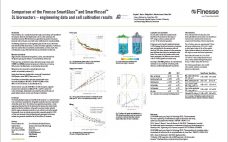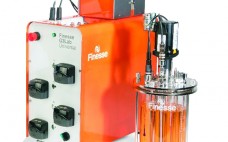Finesse Solutions Inc. recently introduced the single-use benchtop scale SmartVessel 3L bioreactor, which was developed based on its re-usable counterpart, the SmartGlass bioreactor. With identical main geometrical parameters, the plastic bioreactor mimics the glass vessel with minor modifications for manufacturability. The following study focuses on the engineering data of both vessels, which have been determined with special focus on animal cell culture applications. Furthermore, data from material tests on leachables and extractables as well as results from cell cultivations using…
Author Archives: Stephan C. Kaiser
Experiences with a Benchtop-Scale Glass Bioreactor: Engineering Data and Cultivation Results
Animal cell lines (the dominant expression systems in biopharmaceutical production processes) are mostly cultivated in stirred bioreactors (1). Although such bioreactors are widely accepted and applicable over a wide range of scales, engineering data for these systems are still lacking. Nevertheless, studies have shown that the correct choice of key parameters (e.g., power input, tip speed, mixing time, and oxygen mass transfer) can influence the growth of animal cell cultures (2). Therefore, detailed characterization is essential. It enables reliable scaling…
Cultivation of CHO Suspension Cells: SEAP Expression in the Finesse Glass Bioreactor
This application note describes the cultivation of Chinese hamster ovary (CHO) suspension cells in the Finesse SmartGlass vessel bioreactor with a maximum working volume of 2.0 L. Using chemically defined minimal media, cell densities of up to 7.44 106 cells/mL were achieved. Recombinant secreted embryonic alkaline phosphatase (SEAP) expression was induced by medium exchange and temperature shift. Maximum SEAP activities of up to 63 U/mL were reached. A novel stirred glass bioreactor suitable for cell culture applications at benchtop scale…
Cultivation of CHO Suspension Cells and SEAP Expression in the Finesse Glass Bioreactor
This application note describes the cultivation of Chinese hamster ovary (CHO) suspension cells in the Finesse SmartGlass vessel bioreactor with a maximum working volume of 2.0 L. Using chemically defined minimal media, cell densities of up to 7.44 × 106 cells/mL were achieved. Recombinant secreted embryonic alkaline phosphatase (SEAP) expression was induced by medium exchange and temperature shift. Maximum SEAP activities of up to 63 U/mL were reached. A novel stirred glass bioreactor suitable for cell culture applications at benchtop…



